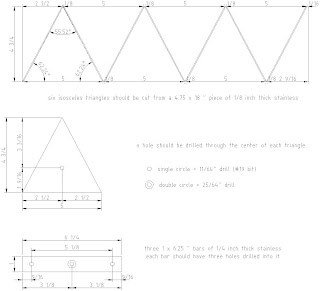

The idea behind the float is that mirror flexion can be minimized by distributing the points of contact to support sectors of equivalent weight, taking into account the curvature of the parabolic mirror. There needs to be a 3 fold rotational symmetry to the points as well as some flexibility to the whiffletree so that collimation can be accomplished easily. I wonder, though, whether this particular solution, found in Dave Kriege's book, attributed to Dave Chandler, and the basis of scores of scopes, is really optimal. An interesting question that I may try to solve with simulation one of these days. But for now the float is built, so that's that!
I've decided to use Loctite Anti-Seize (Silver Grade) on the collimation bolts, since it is an all stainless construction so far. I hope it suffices to prevent galling/welding of the collimation bolts to the frame under the approximately 26/3 lbs of force they will be turned against.
Next, on to the secondary cage. This means I have to buy a router (no, the other kind).










